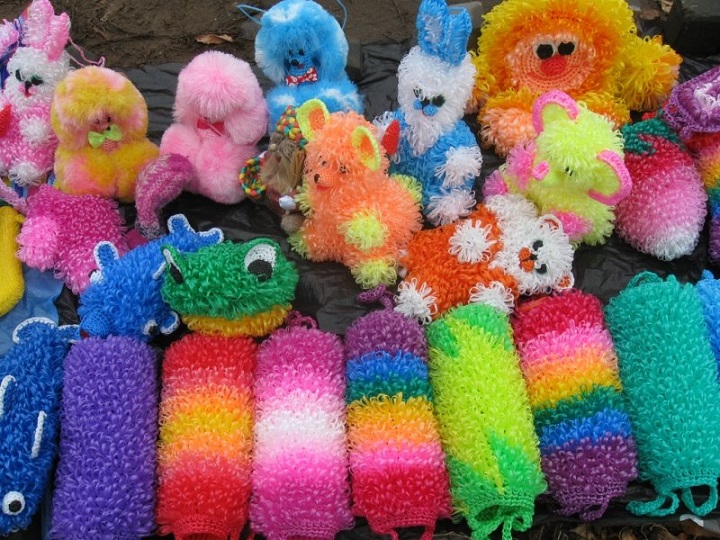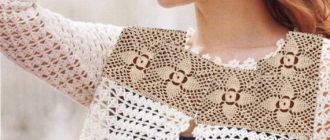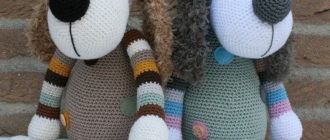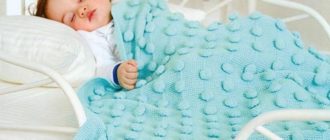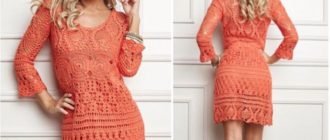This article tells how to crochet a washcloth for beginners. Here you will find detailed descriptions, step-by-step instructions, master classes and schemes for work.
Contents
- How to choose the right material for knitting a washcloth: tips
- Which hook to choose?
- Crochet basic elements
- How to tie a washcloth with a hook with elongated loops: diagram, description
- Crochet single -layer washcloth for beginners: Description
- Video: The best washcloth crochet-Master class
- Simple washcloth without elongated loops: step -by -step instructions, video
- Video: Crochet washcloth. A washcloth without elongated loops.
- Crochet washcloth for beginners in the form of a mittens: description, diagram, video
- Video: washcloth - Shatlen mitte
- Children's washcloth Crochet: Description, video
- Video: Wargler-toy Hedgehog. Master class for beginners from Shatlen
- Crochet lush washcloth for beginners: description, video
- Video: washcloth ball. Master class for beginners from Shatlen.
- Crochet round washcloth for beginners: step -by -step instructions, diagram, video
- Video: Crochet round washcloth. SHATLEN master class.
- Crochet washcloth for beginners with a pattern of “bumps”: step -by -step instructions, video
- Video: Crochet washcloth. How to learn to crochet?
- How to knit handles for a washcloth: description
- Video: Crochet washcloth for beginners
In the modern world, it still does not do without work with your own hands. There are many different hobbies, but one of the oldest that our grandmothers also taught us is knitting.
- Most needlewomen make things to make a gift to their loved ones. They knit sweaters, scarves, hats. All this will certainly appeal to the gifted and will remind him of the love with which such a gift was created to the owner. But you can tie a simpler product.
- In this article, novice needlewomen will be able to learn to create a unique washcloth on their own, and you will also learn how to choose threads so that the washcloth is good.
How to choose the right material for knitting a washcloth: tips
Specifically, polypropylene threads are best for creating this product, but it is important to choose not very thick. They are strong in themselves and in their structure resemble the material used to create purchased washcloths.
If such yarn cannot be bought, it can be easily replaced with other synthetic threads, but it is important not to forget that you need to choose the right material for work and the thread for the manufacture of the washcloth should be durable.
Which hook to choose?
Success in this work depends on both good threads and on a correctly selected tool. So, what hook to choose:
- First of all, you should be comfortable to work with your hook.
- He should not get your hands and yarn.
- You should not get your hands if you are engaged in knitting for a long time.
- For this type of work, it is better to use a hook №4 Or any other, but average thickness.
It is also desirable that the hook head is not too sharp, otherwise the strings will cling and fluff, and the finished work will not look neat.
Crochet basic elements
Even a beginner should know that before starting to knit according to the scheme, you need to tie a knot. Here are the main elements of crochet:
When you tied a knot, tie a chain of air loops. First, this work is performed as follows:
- Capture a working thread with a tool (hook).
- Pull it with a hook through a loop in which the hook rod is located.
Advice: Knit air hinges as freedom as possible, this will allow you to easily do the first row, which is usually made up of crochet columns.
Then knit this way:
- Pass the hook in one of the air loops.
- Crochet thread with out. Parties.
- Pull the captured thread into the loop in which the tool is located.
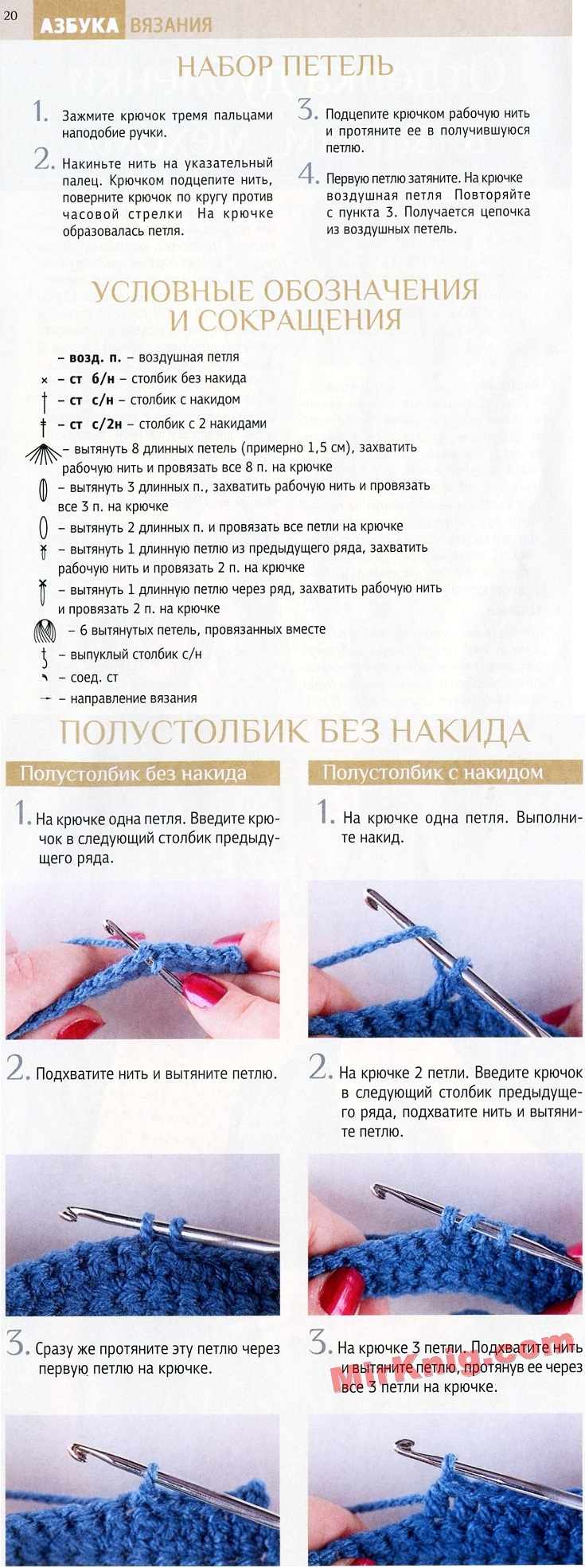
Now you can start creating a washcloth.
How to tie a washcloth with a hook with elongated loops: diagram, description

Before proceeding with the knitting of elongated loops, you need to create the basis of the washcloth on which the loops will be located. Do the following:
- Dial a row. Pet., connect them.
- Then, as you want, as fantasy tells, knit rows consisting of a pole. Without a stump. (or with nak. If you want to speed up the process).
- Now tie Pet. rise. It is important in order to smoothly go to the subsequent row.
- A column without a pitch Pete. Get hooked on a new row.

At the next step, proceed to the creation of elongated loops:
- Pass the tool in the arch that forms a pillar. In the previous row.
- Create a loop, catch the working thread with your thumb, and make a ring out of it.
- Crochet into the loop of the main part.
- Close the created ring.
- Pull it through the loop just made, but not completely.
- Broke the threads forming the circle again.
- Now all together stretch through the main loop.

To create the product, knit elongated Petes. As described above. You choose the size of the product yourself, so you yourself adjust the number of bound loops.
Important: Do not forget to knit a loop of climbing onto a new row and cling to the pillar. Without nak., so that the ranks are not mixed up. When the required length of work is reached, complete the viscosity with columns without crochet.
It is recommended to do the same number of rows as at the initial stage. If you are an inexperienced craftswoman, then first practice to knitting such a product on simple elements: air. Pet. And columns without crochet. In order, then, having started the process, to own some experience of knitting.
Advice:Such a product turns out lush, but if you want to betray it a larger volume, you should knit with a double thread. This is done in the same way as described above, but before starting work, you need to take two ends of the ball of the yarn and knit at the same time, folding them.
You will find a schematic image and step -by -step description of the knitting of a washcloth below in the text.
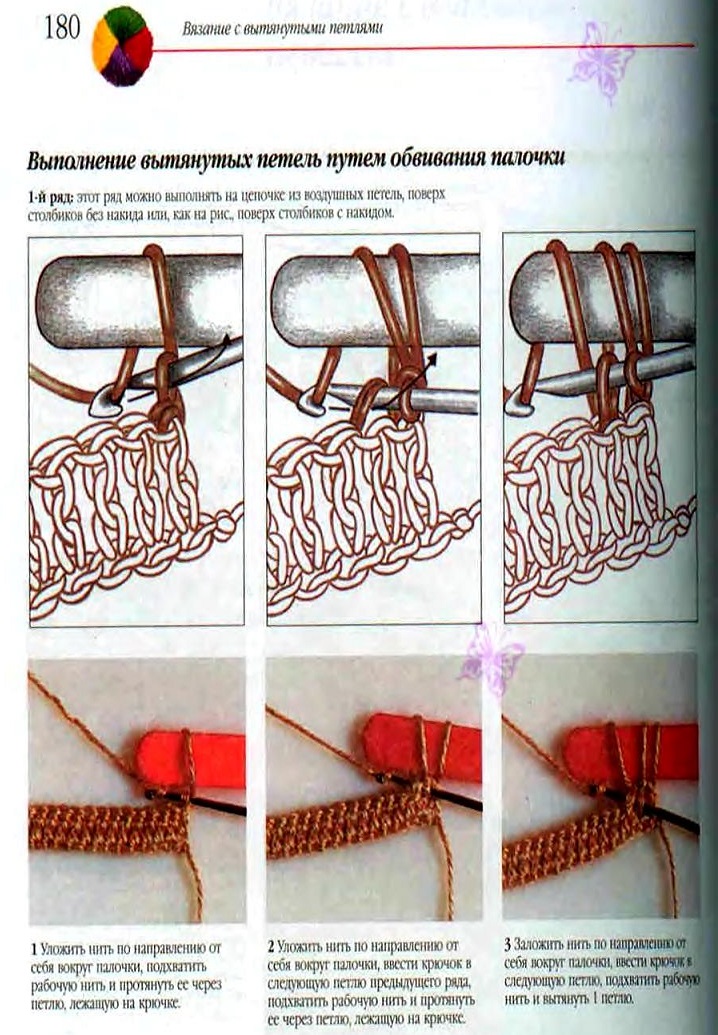
Crochet single -layer washcloth for beginners: Description
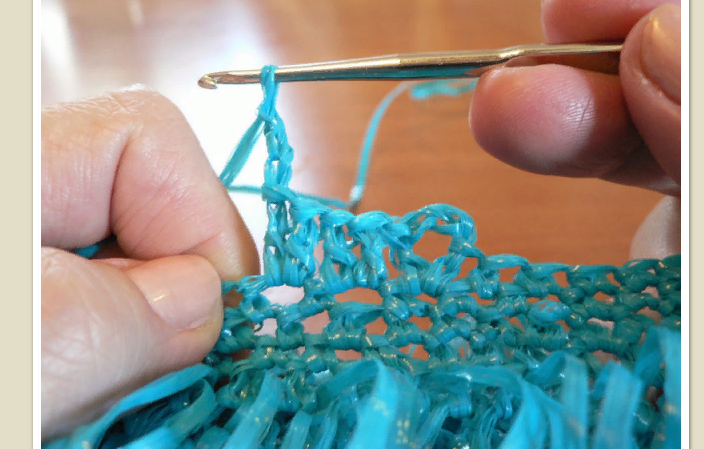
One of the simplest types of washing products related to craftswomen that have not yet gained experience is a single -layer washcloth. Working on it, you can also experiment with a viscous one or two strings, as well as with the number of colors. The scheme of this washcloth does not require a detailed description.
For its manufacture, knit elongated loops. Do the work like this:
- Tie a column with air. Pet. Plus one loop of lifting.
- The next row consists of ordinary columns.
- Then you can make rows from any columns.
- Knit so until a product of a suitable size is obtained.
To start or finish knitting, knit 5 poles. With cloak. In the following are the loops of the product. As a result, the following should turn out: in the same loop from which 3 output rose. Pet., you knit 5 tbsp. With nak. And in one loop - two poles. with nak., in the second - two poles. crochet. Look and do as in the photo above. You will find a schematic image and step -by -step description of knitting the washcloth knobs below in the text.
Video: The best washcloth crochet-Master class
Simple washcloth without elongated loops: step -by -step instructions, video
Here is another option for creating a simple little thing for washing. It fits without elongated loops. To create it, you can choose any threads that you like. If you want to make this little thing with a massage effect, then buy thick polypropylene. If the product is softer, the threads of the x/b are suitable.
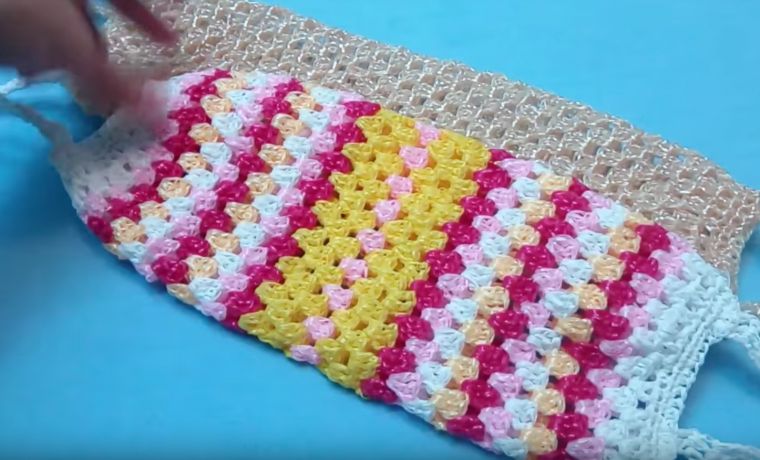
This is the most ordinary washcloth. She just and quickly knit. In half an hour you can go to the bathhouse or shower with her. So, below you will find a schematic image and a step -by -step description of the creation of a single -layer washcloth for beginners without a prot. Pet.
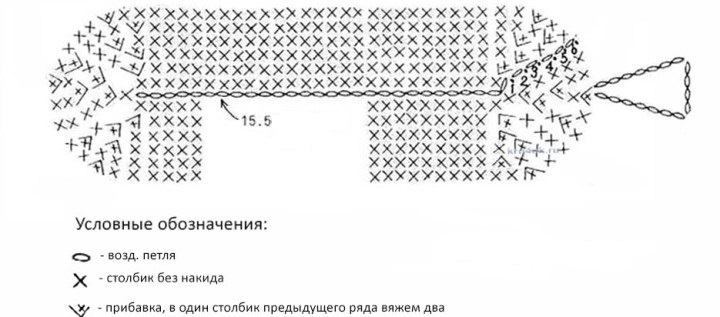
Now start work:
- Tie 7 airy Pete.
- Combine them into a circle.
- The first row consists of ordinary crochet columns. Gradually, when you see that the washcloth begins to expand, reduce the number of loops through a row.
- After about 5-7 rows of knitting simple columns, you should get a figure similar to a “cup”.
- Continue knit to the desired size.
- When tie to the end, place the base inside (for example, round foam rubber), make a pen.
- You will find the scheme and instructions for knitting the washcloth handles below the text.
Important: If you need to create a washcloth for washing for a child, choose softer threads so that the baby does not have irritation on the skin. You can replace polypropylene threads with linen. They are quite pleasant to the touch and will not hurt the skin of the child. They can be used when creating any type of product for your son or daughter.
Video: Crochet washcloth. A washcloth without elongated loops.
Crochet washcloth for beginners in the form of a mittens: description, diagram, video
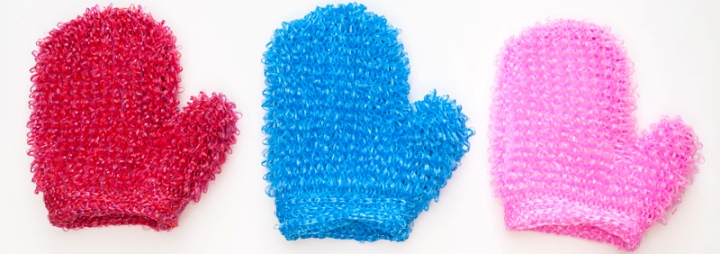
It is convenient to wash yourself with such a trenches and the child. It is simply knitted, despite the fact that this is not a “pipe” and a single -layer wet, as in previous versions. Here is a knitting scheme for such an original washing sponge:
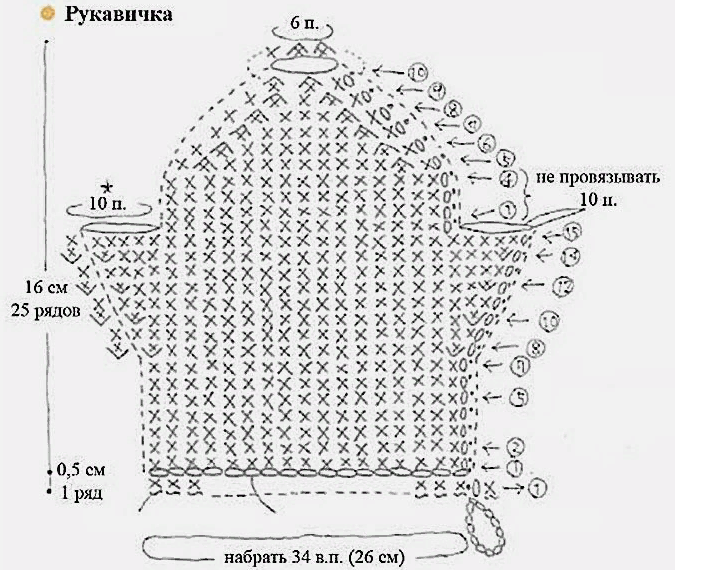
Knit the product like this:
- First, tie 34 air. Pet. We make a ring.
- Better try to knit more tightly with ordinary columns in a circle.
- To go to the next row, knit one air. loop.
- Tie 5 rows, repeating actions in paragraphs 2-3.
- After knit the elongated loops.
- When you reach the length you need, complete the product with air loops, connecting the upper and lower parts of the milestone. Stitch the column and fix it.
- When you sew all the parts, tie a thread with a thread.
For such a washcloth, a handle is not needed. But, if you want it to be stored in a hanging position, then you can tie the pens.
Video: washcloth - Shatlen mitte
Children's washcloth Crochet: Description, video

If it is difficult for you to persuade the baby to go to the bath, then this version of the washcloth is definitely suitable. A peculiar washcloth-toy will attract the attention of the child, and he will be impatiently set off to wash. For this washcloth, it is necessary to prepare two colors of durable polypropylene threads.
Start work with the creation of a loop, with which then your milestone can be hung. To do this, you need a chain of Pet. They knit simple columns on them. Now proceed to the creation of the hedgehog himself:
- Tie 3 air. Pet.
- Close Petes. For a trenches with a column without a nak. On the opposite side of the work.
- Next, knit 32 air. Pet., Combine them into the ring.
- Then everything is wet fits without lifting loops.
- In the next two rows, knit 36 \u200b\u200bsimple columns.
- Now the elongated loops begin. Next row: 24 out. Pet., 12 column. No crochet. Repeating this row, knit another 30 rows. This ends the needles of the hedgehog.
Now change the color of the working thread and start knitting the hedgehog head. You can leave a long end of the thread to then make a hedgehog and eyes. Continue:
- Knit columns without crochet for 5 rows (36 columns each).
- After that, you need to start narrowing the rows. To do this, every eight columns knit two columns together (a number of 32 crochet columns should be obtained).
- In the same way, we narrow the subsequent rows. Come to a row in which there will be 12 crochet columns. Cut the white thread. She will no longer be needed.
- Again, take the color with which they knitted the needles of the hedgehog. It is knitted for a row consisting of twelve columns.
- Now you need to narrow again. To do this, a simple column is knitted through each loop. As a result, 6 columns should remain.
- Repeat the execution algorithm from the last row: also skip one loop.
- Complete the connecting column.
- Tighten the remaining thread inside the milestone.
- With the help of the needle, embroider your eyes. The hedgehog is ready.
Similarly, you can tie other animals: frog, bear cub, pig. Knitting schemes:
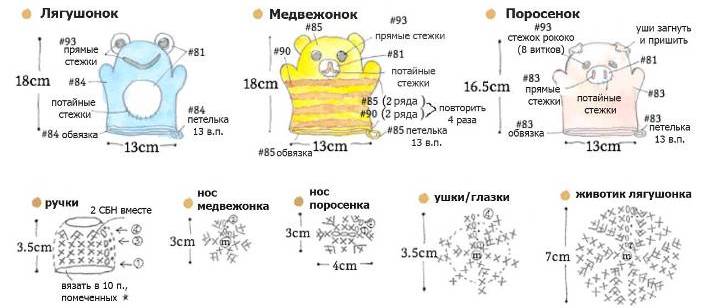
Now your baby will definitely not want to leave the bathroom, so he will like to swim with his new toys. If something is not clear to you in the process of work, then watch the video. In it, the craftswoman tells in detail and shows how to knit a washbasin-hedgehog.
Video: Wargler-toy Hedgehog. Master class for beginners from Shatlen
Crochet lush washcloth for beginners: description, video
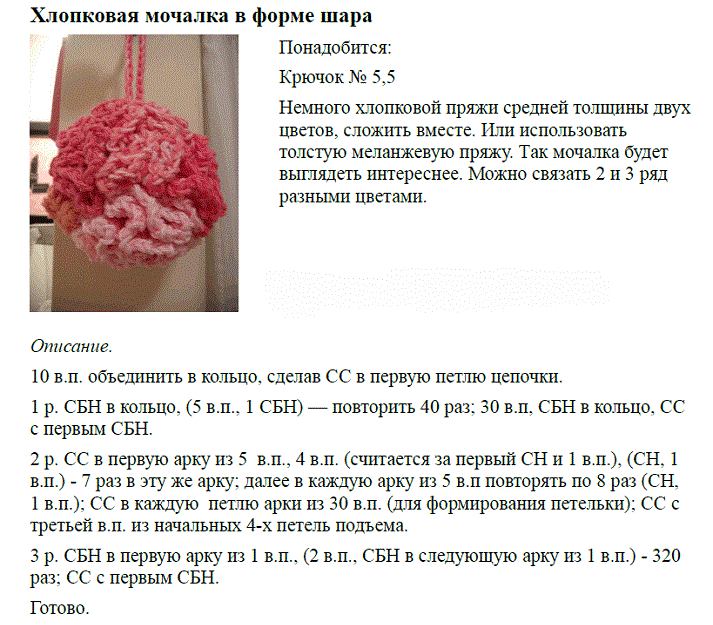
This type of washcloth in shape resembles a magnificent round ball. It looks very pretty and can be a wonderful gift to your friends and relatives.
When knitting this product, you need to take the hook thicker.
Advice: Buy melange - these are threads that throughout its length several times smoothly change their color. You can also take threads a couple of colors and fold them together.
Such a product is knitted best with cotton yarn. So, the washcloth will acquire the necessary density and will remain soft enough. Do the work like this:
- Tie a ring of 10 output. Pet.
- The first row consists of arches. To make them, you alternate one simple column and five air loops. Do it 40 times.
- Still knit 30 Pet.
- Connect the row using a connecting column.
- Close the connecting column in the first arch.
- We make another arch of 4 air. Pet. And a column with a nap. This window.
- Then knit one air loop plus a crochet column (7 times in this place, then 8 in each next window).
- Knit the connecting column in each loop of the window of 30 WHOs. Pet. (to create a loop).
- Finish the row with a connecting column in the third air. Pet.
- Tie a crochet in the first window (from one air loop).
- Then make a transition consisting of two Pet., a column without a crochet in a window, etc.
- Do this 320 times, finish with a connecting column.
The washcloth is ready. Watch the video how an experienced craftswoman knit her.
Video: washcloth ball. Master class for beginners from Shatlen.
Crochet round washcloth for beginners: step -by -step instructions, diagram, video
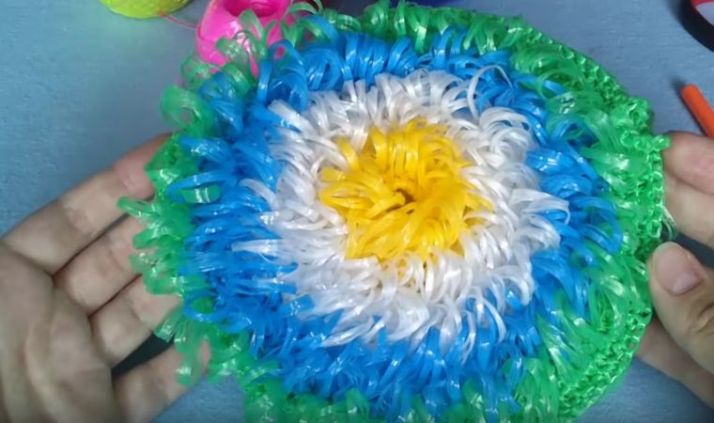
Such a washcloth will look like a flower with its appearance if you perform it in the corresponding color scheme. It resembles some for some. Both associations are accurate, it all depends on your imagination. When knitting it, multi -colored threads are used, the sequence of which you choose yourself. It is recommended to work in one thread so that the washcloth is neat.
Here is a knitting pattern of such a product:
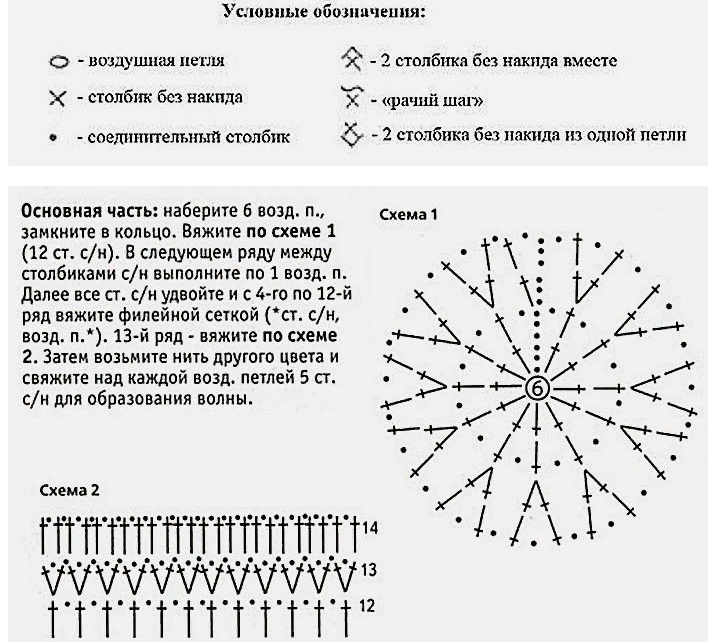
Do the work like this:
- Tie a ring of air loops.
- With the help of Pet. Raise start a new row and knit ordinary columns.
- The second row all consists of elongated loops, knit them in the intervals formed in the previous row. Do not forget to consolidate elongated loops.
- Make a loop of lifting, and then again a row of ordinary columns. It is important not to forget to increase their number, because otherwise your washcloth will not turn out round, but will grow in height.
- To increase the number of columns, knit them 1: 2 in each cell.
- The next row again consists of elongated loops.
So, alternating these actions, you will achieve the desired result. Gradually add new colors so that your trenches turn out to be bright. But the product can be tied from threads of the same color. Tie the handle (the description of the process below in the text) and the original wet is ready.
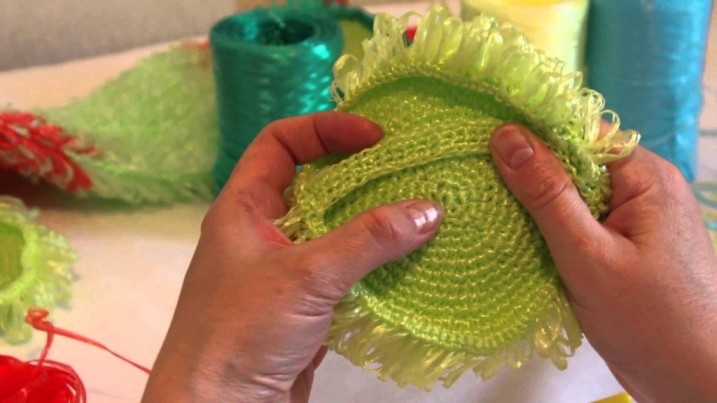
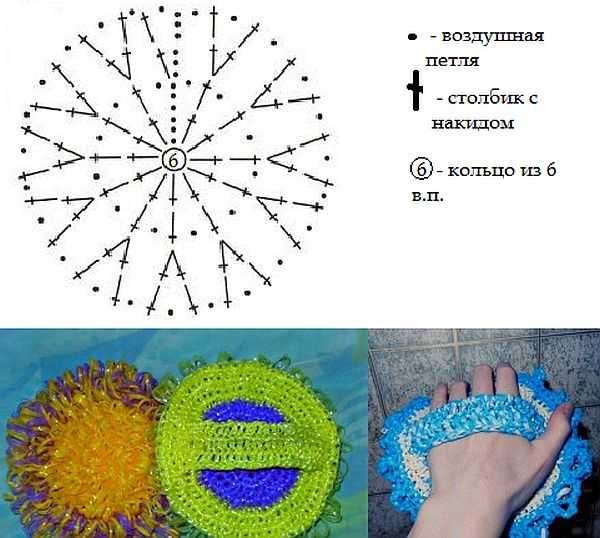
Video: Crochet round washcloth. SHATLEN master class.
Crochet washcloth for beginners with a pattern of “bumps”: step -by -step instructions, video

The plus of such a scheme is that this product will turn out to be lush in any way, and you do not have to suffer with elongated loops, if you suddenly do not understand how to knit them. For this work, it is also advisable to use a tool of medium thickness and a double layer of thread. Work on knitting will be performed as follows:
- The first thing you need to do is to dial a chain of air, you need an even amount (34-40).
- With the help of the lifting loop, you climb the next row and knit ordinary columns throughout the entire row.
- We rise with the help of two Pet., And we knit a column for a whole row. crochet. At the end of the row, we definitely make a set. column.
- 3 and 4 rows also consist of crochet columns.
Start the pattern:
- Make two Pet.
- Then insert a hook between the columns from the previous row.
- Make a cloak, stretch through one loop between the columns.
- Make a second cloak, stretch through the loop.
- Make the third cloak and pull through all the loops. "Shishechka" is ready.
Now, having missed two columns, make another “bump”. All subsequent “bumps” are made, starting from two crochet. Thus, our first consisted of three crochet, and all the others should be out of four. Knit further:
- Tie the number of rows you conceived.
- We cross each new row with two air loops.
- Following, as you finished rows from the “cones”, it is necessary to complete the knitting of the product.
- To do this, do two Pet. And tie a column with a cloak. In the middle of the "shishek" and one on each of them.
- So, you knit rows of crochet columns, then one row of column. Without crochet and complete your work.
Video: Crochet washcloth. How to learn to crochet?
How to knit handles for a washcloth: description
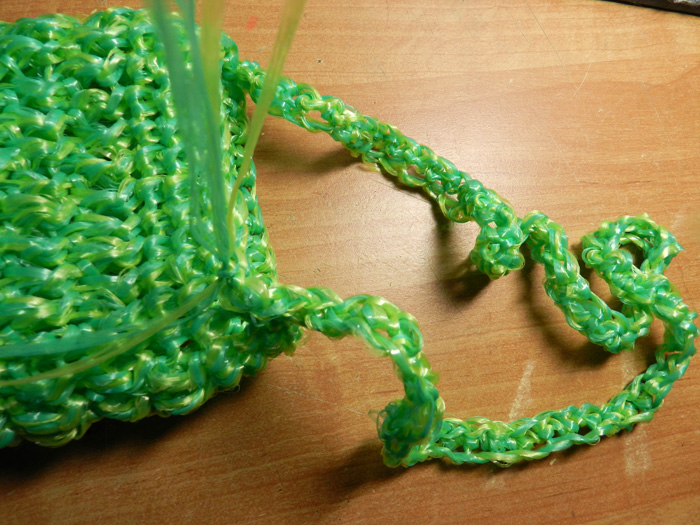
It is recommended to create pens with the same tool with which you made a washcloth so that there is no difference in knitting. Knitting them is simple:
- Tie 8 air. Pet. (5 - row, 3 - lifting).
- In the fifth Pet., Considering from the base, and then in the direction from the hook, make the columns with the NAC. The first row is ready.
- Next, knit 3 air. Pet., turn the future washcloth inside out.
- The second row consists of 4 poles. With nak. Then again three loops.
The scheme for the entire strip is the same. You can tie 17 rows - it will be about 20 cm. Now adjust the length of the strip - knit less or vice versa, more loops.
Important:There are different options for further work: you can sew such pens to the finished milestone or knit the product itself from the end of the bound handle.
Now you know that knitting implies the creation of not only clothing items. There are many decorative things and household items created independently using yarn and tool. Training in knitting a washcloth will serve as an ideal start to study the basics of knitting, because the schemes of its work are quite simple, and throughout all the work you will need to do, in fact, the same elements.
We taught you to knit different types of washcloths, and you also remembered some of the main knitting techniques. Agree that creating such a product with your own hands is simple, fast, and most importantly, nice. After all, you make it for your relatives. Good luck!

